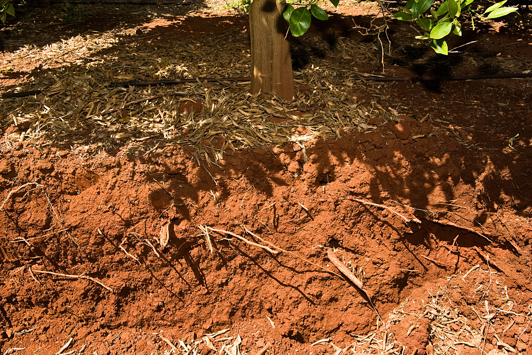How to use the tool:
Enter the name of a weather station and select it from the drop-down list.
Select a soil type and whether the model is for a fallow or cropped situation from the drop-down lists below.
Graphs can be downloaded and saved by clicking on the three horizontal lines to the right of the graph title.
Maps of plant available soil water, updated monthly in the early part of the growing season, can be viewed, and downloaded.
The Soil Water tool is modelled using the Ritchie two-layer fallow evaporation model. The model is described in Ritchie, J.T. 1972, Model for predicting evaporation from a row crop with incomplete cover.
Soil type depths
Plant available soil water models are run for ten different soil types that have been characterised according to their water-holding capacity. The soil types assume there are no constraints to crop root growth when there is available soil water. Their depths are shown in the following table.
| Table 1: Soil type depths (cm) | ||
|
Soil type |
Layer 1 |
Layer 2 |
|
Gravel |
40 |
50 |
|
Shallow soil |
40 |
20 |
|
Sand |
40 |
210 |
|
Sandy earth |
20 |
230 |
|
Shallow sandy duplex |
20 |
160 |
|
Deep sandy duplex |
40 |
110 |
|
Shallow loamy duplex |
20 |
130 |
|
Deep loamy duplex |
40 |
140 |
|
Loamy earth |
40 |
210 |
|
Clay |
40 |
210 |
For a complete description of the soils and their characterisation, see Oliver, Y.M. and Roberston, M.J. 2009, Quantifying the benefits of accounting for yield potential in spatially and seasonally responsive nutrient management in a Mediterranean climate, Australian Journal of Soil Research 47(1)
Evapotranspiration
Evapotranspiration of a generic wheat crop is estimated using the Food and Agriculture Organization (FAO) crop factor method, where the timing of crop germination (break of season) is estimated using a two-part rule, such that germination is assumed to occur if there is 25mm of rainfall over three days after 25 April and before 5 June, or if there is 5mm of rainfall over three days after 5 June.
The FAO crop factor method assumes that post-germination, there are four stages of crop growth. On any day during the crop lifecycle, the crop coefficient for the crop's growth stage is multiplied by the potential evaporation to give an estimate of plant evapotranspiration. Coefficients have been selected to suit WA wheat cropping.
|
Table 2: Stages of growth for a wheat crop |
||
|
Growth stage |
Length |
Crop coefficient |
|
Initialisation |
15 |
0.3 |
|
Development |
20 |
0.3 |
|
Mid |
80 |
1.15 |
|
Late |
45 |
0.5 |
While plant available soil water graphs can help create a narrative for the progress of a crop and aid key in-season decision-making, other key factors also need to be considered for any given crop to arrive at an accurate picture. These include:
- Soil status and characteristics including stored soil moisture, soil water-holding capacity and any barriers to infiltration.
- Stored nitrogen and other nutrient availabilities.
- Factors such as non-wetting, waterlogging through topography or impermeable layers, leaching or dispersible clays in the soil.
The timing and event intensity of rain during the growing season can also greatly influence the conversion of rainfall to biomass and yield.

